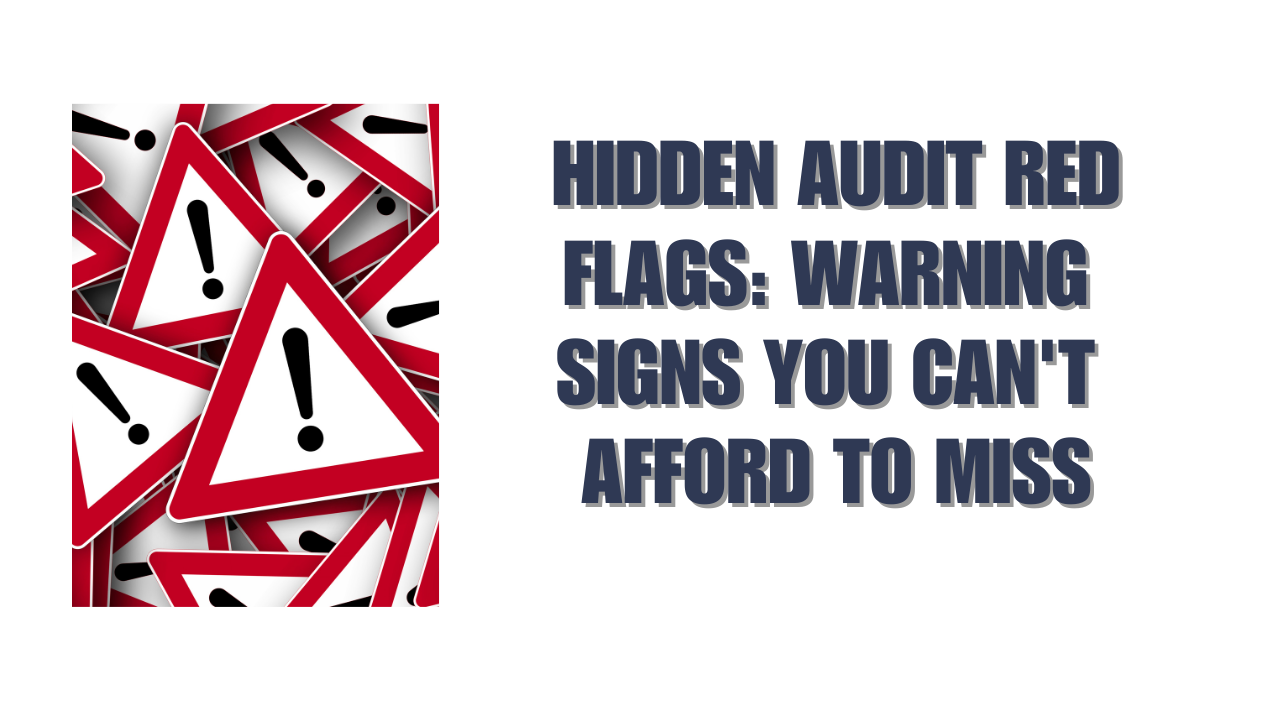Audit red flags can drain thousands or maybe even millions from your organization if you miss them. Your business needs to spot these warning signs early to avoid major expenses and hassles, whether you’re going through a financial review, compliance check, or tax examination.
Tax audit red flags need extra attention if you’re self-employed. The IRS targets people earning more than $200,000, with almost 4% of high earners getting audited versus just 1% of others. Your business might catch the IRS’s eye quickly if you show losses year after year. Research shows 69% of organizations call the quality of compliance reports very important. Quality ranks as the top factor for 22% of businesses choosing an auditor.
This piece will get into warning signs that often slip by unnoticed in audits of all types. We’ll look at everything from vague language and basic reports to technical issues that could point to bigger problems. You’ll learn about specific red flags that matter to self-employed professionals and what you should do when these warning signs pop up in your audit reports.
Common Audit Red Flags You Shouldn’t Ignore
You can avoid getting hit with pricey compliance issues by spotting suspicious patterns in audit reports. I’ve helped many clients with their audit processes over the last several years. Here are some warning signs that need your immediate attention.
Perfect reports with no exceptions
Clean audit results should make you suspicious. Real audits almost always find something wrong – even small issues. Perfect reports usually mean the testing was shallow or someone ignored problems on purpose. A full audit naturally spots areas that need work, which is why spotless results often show the auditor didn’t look hard enough.
Vague or generic language in findings
Quality audit reports use clear, specific language. Watch out for vague statements like “controls appear adequate” or “no significant issues noted” that lack supporting details. Good auditors give concrete examples, specific test results, and clear recommendations. Findings without specifics often hide poor testing or undocumented problems.
Short or overly simplified reports
Short reports aren’t better in auditing. Complete audits create lots of documentation. A three-page report covering complex compliance requirements shows the work lacks depth. Good audit reports have sections about detailed methods, specific testing steps, and thorough evidence collection. Brief reports tend to skip critical details about testing limits or exceptions.
Uncooperative or evasive auditors
Professional auditors are happy to answer questions and explain things clearly. Your auditor might be hiding something if they avoid questions, take forever to respond, or get defensive when you ask for supporting documents. Good auditors stay transparent throughout and gladly explain their methods, findings, and recommendations.
Keep in mind these warning signs don’t automatically mean fraud or incompetence, but they deserve a closer look. Quality auditors know their work needs to hold up under review and provide real value beyond just ticking compliance boxes. You should ask for more information or get a second opinion from another certified professional if you notice these red flags.
Technical Red Flags That Signal Deeper Issues
Technical issues in audit reports often point to deeper problems. After looking at many warning signs, I’ve spotted several technical red flags that need your attention right away.
Unclear system scope or audit boundaries
Audit reports need clear definitions of system scope. The scope must specify what’s included and excluded from the audit. Vague boundaries create major risks because you and the auditor can’t be certain what was actually checked. A well-defined scope covers both applicability (what products and services are managed) and boundaries (organizational structure and physical/virtual sites). Poorly defined scope makes it impossible to know if the auditor checked all relevant controls properly.
Undefined subservice organization responsibilities
Critical services often come from third-party vendors. These “subservice organizations” need clear identification in audit reports along with their specific duties. You can’t determine control accountability without this clarity. The report must describe relevant subservice organization controls and reference that organization’s own audit report. This check will give a clear picture of whether responsibility lies with that organization or a fourth-party provider.
Missing user entity control descriptions
Good audit reports include “complementary user entity controls” (CUECs)—controls you must put in place to make the service organization’s controls work. The AICPA says these should rarely appear in SOC 2 reports. Their absence from reports that should have them raises concerns. These controls need clear descriptions that readers can understand easily.
Lack of follow-up testing on exceptions
The biggest red flag appears when auditors find exceptions but don’t document any follow-up. Auditors must tell management about exceptions, record their responses, and do more testing afterward. Without proper documentation, you can’t tell if anyone fixed the identified issues or just ignored them.
Audit Red Flags for the Self-Employed and Small Businesses
Small business owners and self-employed people need to watch out for specific audit triggers. A good understanding of these red flags can protect your business from investigations that can get pricey.
Mixing personal and business expenses
Mixed funds trigger audits more than anything else. When you pay for groceries and business supplies from the same account, it becomes almost impossible to identify legitimate business expenses. This practice can also “pierce the corporate veil” and eliminate your business structure’s liability protection. Tax authorities look at mixed expenses with suspicion and often reject deductions that should be valid. You need separate accounts not just as good practice but to protect yourself during audits.
Claiming repeated business losses
Your business will catch attention quickly if you report losses year after year. The IRS expects legitimate businesses to show profit in at least three out of five years. Multiple years of losses make them think you’re running a hobby instead of a real business. You risk losing all related deductions without proof of genuine profit-seeking activities.
Misreporting or rounding income
Any inconsistencies in income reporting will raise audit flags immediately. You put yourself at high risk by rounding figures, averaging income instead of reporting actual amounts, or missing income sources. Tax authorities use sophisticated systems to spot suspicious patterns, especially round-number refunds that strongly associate with negative audit outcomes.
Excessive deductions not arranged with income
Red flags go up when your deductions seem too large compared to your income. Note that legitimate business expenses must be:
- Both ordinary and necessary for your industry
- Properly documented with receipts
- Reasonable in amount relative to your income
Large cash transactions without documentation
Businesses that deal heavily in cash face extra scrutiny, especially those with undocumented large transactions. Additional tax assessments happened in nearly 70% of 11,000 business audits conducted in one year. Cash-based businesses must keep detailed records of every transaction to avoid assumptions about unreported income.
What to Do If You Spot These Red Flags
You need to act right away after spotting concerning signals in your audit. Quick action on audit red flags can stop things from getting pricey and protect your business reputation.
Ask your auditor for clarification
Your first step should be reaching out to your auditor with specific questions. Miscommunications happen, and making sure you both speak the same language matters. Nobody expects you to understand vague findings—saying “I don’t know” and asking for clearer explanations works perfectly fine. A professional auditor will gladly explain their methodology and findings. Their refusal to work with your questions raises most important warning signs.
Request supporting documentation
Quality audits need solid documentation. You should ask for materials that help anyone—even someone who knows nothing about the transaction—understand what happened and management’s analysis. Good documentation shows a full assessment against applicable standards. Companies that need external audits should work with their auditors early to confirm documentation requirements.
Consider switching to a certified or accredited auditor
The time might come to look elsewhere if your current auditor can’t give you enough answers. Professional auditors should help you understand their reports without hesitation. Watch out for those who get defensive or dodge questions.
Use audit support services if needed
Expert outsiders can help as go-betweens with auditors to make everything less stressful. These specialists know how to spot trouble ahead, fix records that aren’t “audit-ready,” and help write technical accounting memos for complex deals. They prove especially valuable during first-time audits or when your team needs specific audit expertise.
Conclusion
Businesses of all sizes need to pay close attention to audit red flags. In this piece, we’ve gotten into warning signs that could get pricey with compliance issues, penalties, and full investigations. Spotting these signals early definitely makes the difference between small fixes and major financial problems.
Self-employed professionals face higher risks when their money management raises IRS eyebrows. Having separate business accounts isn’t optional – it’s a must. Every transaction needs proper documentation, and this becomes even more critical with cash-based operations to avoid questions about unreported income.
Clean audit reports without any issues should raise eyebrows instead of providing comfort. Real audits usually find at least a few things that need work. Watch out for vague wording and oversimplified reports – they often point to inadequate testing or deliberately skipped problems.
Technical red flags usually show deeper problems that are systemic. Red flags like unclear system boundaries, fuzzy responsibilities, and missing control details suggest gaps in audit coverage. The biggest problem is skipping follow-up tests on exceptions, which makes the whole audit meaningless.
What should you do when these warning signs pop up? Ask questions right away. Good auditors welcome your questions and explain things clearly without getting defensive. It also helps to ask for backup documents that show complete testing. If your worries aren’t addressed, you might need to switch to a certified auditor.
These audit red flags work as an early warning system to protect your finances. Quick identification lets you tackle potential issues before they turn serious. While audits might seem overwhelming, knowing these warning signs equips you to stay compliant and protect your business’s future.
FAQs
Q1. What are some common audit red flags that businesses should be aware of?
Common audit red flags include perfect reports with no exceptions, vague language in findings, overly simplified reports, and uncooperative auditors. These signs may indicate insufficient testing or deliberately overlooked issues.
Q2. How can self-employed individuals avoid triggering an IRS audit?
Self-employed individuals can reduce audit risks by maintaining separate business and personal accounts, avoiding repeated business losses, accurately reporting income without rounding, ensuring deductions align with income, and properly documenting all cash transactions.
Q3. What should I do if I notice red flags in my audit report?
If you spot red flags, first ask your auditor for clarification. Request supporting documentation to better understand their findings. If concerns persist, consider switching to a certified auditor or using audit support services for assistance.
Q4. Why is a clear system scope important in an audit report?
A clear system scope is crucial because it defines what’s included and excluded from the audit. Vague boundaries create significant risks as neither you nor the auditor can be certain what was actually examined, potentially leaving critical areas unassessed.
Q5. How often do businesses typically face audits?
The frequency of audits varies, but high-income earners face greater scrutiny. The IRS audits almost 4% of those earning more than $200,000, compared to just 1% of lower-income individuals. Businesses reporting consistent losses or with cash-heavy operations may face more frequent audits.






